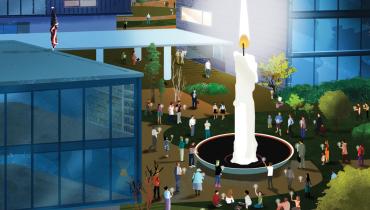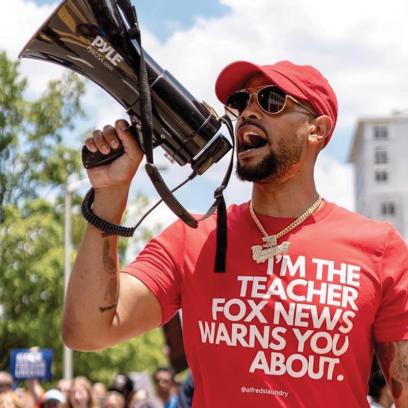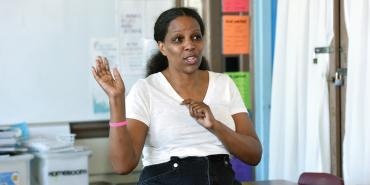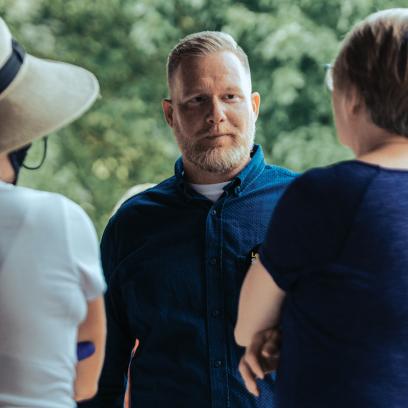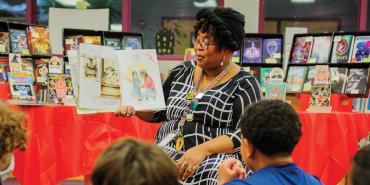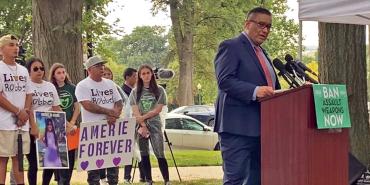In the wake of the Oxford High School shooting in Michigan on November 30, 2021, we checked in on one another in a group text. Like so many educators and school staff across the country, we were shocked, disgusted, distraught, angry, and heartbroken that this had happened yet again: another school shooting bringing death, injury, terror, and abject fear. As teachers, we—and our students—are on the frontlines of America’s gun violence epidemic. But rarely, if ever, does the public hear from those of us enduring these horrific school shootings, caring for kids impacted by shootings in their communities, and fearing that our loved ones or our students will be next.
The news cycle moves fast. Reporters sweep in and out, rarely capturing the authentic scope of trauma and grief, especially the long-term effects of loss and fear. And rarely captured is the everyday gun violence—the domestic violence, suicide by gun, unintentional shootings, and more—that also impacts school communities. At the end of our text thread that horrific day in November 2021, we decided to take action by launching a national organization for and by educators and school staff.
Two of us are school shooting survivors: Abbey, from the Sandy Hook Elementary School shooting in 2012, and Sarah, from the Marjory Stoneman Douglas High School shooting in 2018. Sari is a New York City high school history teacher who, like millions of educators across the country, endures countless challenging drills and conversations with her students about the fears and logistics of an active shooter on campus.
Abbey was teaching her second-graders on the day of the tragedy in 2012. Her surviving students are high school seniors now. They are watching. They are watching a country allow what happened to them and their friends and neighbors happen over and over again. Some of Abbey’s former students have become activists, like her, and some are still trying to process what happened in their childhood town. Teachers Unify to End Gun Violence is dedicated to listening to the voices of young people who have been left with this public health crisis at their feet. Partnering with them, following their lead, building a coalition of generations—this will force the change we need.
Sarah lives with the constant reminder of February 14, 2018. The 1200 building where students and staff were shot still stands. The fire alarm and lockdown drills still trigger her. It’s been a difficult road to navigate through trauma and PTSD. Some days Sarah is OK, and some days she’s not. She knows she has to stay strong for her husband, children, family, and students. She knows that some of her coworkers lean on her for strength. This is what happens when tragedy occurs; a person either finds strength they didn’t know they had or becomes stronger than they already were. This is how Sarah keeps going. She is strong and outspoken, which is why the founding of Teachers Unify to End Gun Violence means so much to her. She is able to use her voice, experience, and strength to help, encourage, and support others—just as those who came before her, like Abbey, did for her.
When Sari’s class went through their first active shooter drill of the school year last fall, she was horrified by the conversation that it generated. Students were discussing an escape route if there were actually an active shooter in the school and determined they would just jump out the window even though they were two stories above ground. Only later did the whole class realize how disturbing it was that they even had to think about how to survive a mass shooting. There’s an important lesson here: even when schools do not become the center of a mass shooting, the specter of the possibility is forever lingering, especially when participating in the drills.
We are union members who work closely with leaders to ensure the public and our elected officials know about these pervasive concerns about safety, fear, and anxiety among children, educators, and school staff. The mission of Teachers Unify to End Gun Violence is to elevate the narratives of current and former educators, school staff, administrators, and other stakeholders impacted by school and community shootings because gun violence leaves no one unaffected. Teachers Unify is expanding the conversation about gun violence by supporting, empowering, and leading with those on the frontlines. Every teacher and school staff member has a story to tell about gun violence and the fear of gun violence. It is imperative that these narratives are heard in order to change hearts, minds, and policies to make our schools and communities safer.
What do we mean by elevating narratives? Through this article, we’re sharing the stories of five educators—Alfred “Shivy” Brooks, Rori Abernethy, Jon Parker, Jean Darnell, and Kiki Leyba—whose experiences with gun violence in their schools and communities offer unique perspectives on why this crisis persists and how we can end it. Likewise, through our podcast (https://teachersunify.transistor.fm), people get to know many more voices and stories of gun violence and how it affects us physically, emotionally, in our relationships, at work, and at home. In addition, through collaboration and support—one-on-one, school- and district-wide, at education conferences, and on social media—we share anecdotes, resources, camaraderie, and tips on how to get a seat at the table to improve districts’ safety plans, how to talk to students appropriately about gun violence, and how to move forward in the aftermath of a school or community shooting.
We hope everyone connected to the education world, whether current or retired, will join us. So many teachers and school staff have decided that enough is enough. The public needs to hear from a coalition of voices speaking up for the safety and well-being of the school community, including those who work there. To become a part of Teachers Unify to End Gun Violence, complete our survey here.
Abbey Clements is an elementary educator with over 30 years of experience. Since surviving the Sandy Hook school shooting in 2012, she has been a gun violence prevention activist working alongside survivors, advocates, and AFT leaders. Sarah Lerner, a survivor of the Marjory Stoneman Douglas school shooting in 2018, has 20 years of experience teaching. The editor of Parkland Speaks, her writing has appeared in several national publications. Sari Beth Rosenberg is an educator with over 20 years in the classroom, the host of the PBS NewsHour Classroom Educator Zoom Series, and a senior adviser for Voters of Tomorrow. Together, Clements, Lerner, and Rosenberg founded Teachers Unify to End Gun Violence.
 The Solutions Our Students Deserve
The Solutions Our Students Deserve
By Alfred “Shivy” Brooks
When I was 21 years old, an incident of gun violence changed my life. My friend and neighbor, Sonny, a senior at our local high school, was shot by another kid after a verbal conflict with other teens. I was an active and aspiring musician at the time, but Sonny’s passing changed that. I stopped listening to music for four years. I just couldn’t stop thinking about carrying my friend’s casket or having to plan for his tombstone. I decided to become a teacher and dedicate my life to making my world safer for Black kids.
One of the sad truths about being an urban educator is the number of students that we lose to interpersonal gun violence. I’ve been a certified teacher in the greater Atlanta region for five years, and I was a substitute for seven years before that. There’s never been a school year—in 12 years—that I have not lost a student to gun violence. Ever. What’s also sad is the number of firearms that we discover in kids’ backpacks or on their person. This year, I feel more unsafe than ever before because of the threat of gun violence in or around my school or at school events. And I don’t think we are having the conversations about gun violence that will produce actionable, sustainable solutions.
The solutions that our political leaders are presenting—adding school resource officers, arming teachers—won’t make us safer. In fact, they will only put students who look like me in more danger. Adding school resource officers means more Black and brown students being adjudicated and put into the justice system, many times just for being kids. And even though I am a gun owner, I believe arming teachers is just as problematic. What happens when a white female teacher is afraid of a Black male student and shoots him in the classroom?
Solving this crisis is going to require addressing the real problems underlying gun violence—which, for communities like mine, are poverty and lack of opportunity. We’ve forced poverty upon so many communities that it is ingrained in the experience of young people, especially Black youth. Street economies become the best option for many of them to provide for themselves and their families. If we want to stop interpersonal gun violence, we have to separate local taxes from how we fund our schools and invest more resources in serving our children and their neighborhoods. We have to make schools into hubs of hope for entire communities by providing adult literacy programs and solutions for food insecurity and unemployment so that our kids don’t have to look to the streets to meet their needs.
Moreover, solving the gun violence crisis means dealing with school climate and culture to ensure students have a sense of belonging. Our schools have become places where Black and brown kids are not empowered to be their authentic selves. They’re forced to code switch to feel welcome or worthy to be in that environment.* And the act of changing how you walk, talk, or dress—changing who you are—just to feel that you belong is exhausting. Some students skip or drop out of school to find other avenues of acceptance. They’re more likely to join a gang or find a job that undervalues their labor, which only perpetuates the cycle of poverty and struggle.
Instead, schools should center culturally responsive pedagogy and the soft skills our kids are really lacking. Now more than ever, kids need to be taught how to dream and reach those dreams, how to see the humanity in each other, and how to navigate conflict using empathy and intellect rather than weapons. We teachers are often told not to talk about politics or share with our students how we personally feel about the issues that our communities and our world are facing. But we’ve become so polarized, unable to disagree and still share space with each other, and that’s partly a consequence of not learning how to process conflict in classroom spaces where it should be safe.
Every time I’ve lost a student, I’ve been re-traumatized, taken back to the day I lost Sonny. He deserved to graduate high school and go to college. He deserved to become a father and leave his own legacy. He deserved to live. Neither Sonny’s death nor the deaths of my students over the last 12 years have made news headlines or prompted legislation to make widespread change. That’s why I use my voice and my relationships to impact the lives of as many kids as I possibly can.
As a teacher, I’ve made my classroom a space for kids to feel like they belong, and I work with colleagues across the country to advocate for learning spaces that are safe for Black and brown children. And I’m politically active in my community, not just in voting, but in pushing for legislation and for leaders that will fight for education and safer schools. I know that the changes I want have to come through me.
Alfred “Shivy” Brooks teaches economics, personal finance, and government at Charles Drew High School in Riverdale, Georgia. He is the chair of the Georgia NAACP Education Committee and founder of Teachers for Good Trouble, which advocates for the well-being of students, teachers, and learning communities. (return to educators)
* To learn more about code switching and ensuring Black students feel that they belong, see “Lift Every Voice: Valuing Black Language and Culture in Classrooms.” (return to narrative)
Our Kids Are Not OK
By Rori Abernethy
I’ve taught middle and high school math in the Bay Area for 21 years—the first 13 in Oakland and the last 8 in San Francisco. My students and I have experienced the fear and trauma of gun violence in both cities. But it took an incident in San Francisco, in which no one was hurt, to cement for me the disparities in America’s responses to gun violence.
In 2018, I was teaching at San Francisco’s James Denman Middle School when a student from a nearby school went on the run after getting caught with a gun. The city’s response was massive. Law enforcement combed the area on the ground and from helicopters; news reporters swarmed around, broadcasting the story to the region. All the neighboring schools were on lockdown for hours. I was shocked at first because in Oakland, the authorities could barely be bothered to show up.
My first teaching job was at a school deep in East Oakland, where the majority of Oakland’s gun violence occurred. In my second week, multiple people were shot on our block. Months later, there was a shootout on the street right outside my classroom. My sixth-graders, who had grown up with gunfire, immediately dropped to the floor, scared but calmly calling their parents. The police strolled in a long while later to take a report, but there were no helicopters or news reporters.
A few years later, I transitioned to Oakland High. The school had wonderful kids and staff, but guns were everywhere. Every week, we found loaded guns in lockers, and we had so many lockdowns because of armed individuals on or near campus that I lost count. Worse, students were always wearing T-shirts with the faces of loved ones killed by gun violence.
The longer I taught at Oakland High, the more heartbreaking stories I had. Stories of students like Xavier, a vibrant boy everyone knew and loved.† Hearing he’d been shot and killed devastated us all. There were almost 2,000 kids in our school, but the hallways were so quiet, it was like an all-school funeral.
Orlando sold weed because his family depended on him for survival. He was always worrying about how to pay their bills. One day in class, he showed his gun to a girl he was trying to impress, and it went off—thankfully, no one was hurt. He was terrified and so apologetic. The police took two hours to show up, and by that time Orlando had run and dumped the gun. Afterward, the community stayed in touch with him and made sure he finished high school. He didn’t deserve to have his life ruined for a dumb decision.
When guns are allowed to proliferate in our communities, our kids pay the price. Kids like Terrence, one of many who sold weed or bought and sold guns when “flip that gun” was popular in Oakland—and figured they didn’t need a high school diploma because they were entrepreneurs. I warned Terrence that this “business” would end up with him in jail, disabled, or dead. Two days later, he was shot in the head. He survived but is severely disabled.
Vu had been involved in gangs but was turning his life around. He became a straight-A student and a talented peer tutor. Vu wanted to be a police officer, and I remember the beautiful letter his dad wrote me, full of excitement about his son’s future. One Halloween, Vu and his friends were in a park where a girl was shot and killed. He was tried as an adult and sentenced to life in prison—at 16 years old—but I believe he is innocent.
One summer, Joseph was in a course I taught for students who needed to pass the California High School Exit Exam. We were in the library when we heard gunfire. Another kid everyone knew was killed. When the grief counselors arrived, Joseph asked me to send them away. He’d lost so many people to gun violence that he couldn’t process another shooting. He needed to pass the class, and he couldn’t do that and focus on his mental health. “I already know I’m not going to be OK,” he said.
I still cry over these stories. What if I’d asked Xavier or Vu to stay after school or had one more conversation with Terrence? What if we’d changed gun laws 20 years ago or invested in these kids and communities across America that nobody cares about?
The kid who shut down our schools that day in San Francisco had a better end to his story. People advocated for and supported him instead of just punishing him for his mistake. My students in Oakland deserved the same. What happens to the least of us eventually happens to all of us. We need to care enough about all our kids, no matter where they come from, to take meaningful action on gun violence. If we don’t do something now, none of us will be OK.
Rori Abernethy teaches math at James Denman Middle School in San Francisco. She is also an AFT Black Caucus regional organizer and serves on the Public Education Enrichment Fund Community Advisory Council for the San Francisco Unified School District. (return to educators)
† Students’ names have been changed to protect their identities. (return to narrative)
 More Than Names on a List
More Than Names on a List
By Jon Parker
Late at night last Easter, I found myself unable to sleep. I was gripped by nervous anticipation, waiting for a list of names of victims from a mass shooting three miles from Perry High School in Pittsburgh, the school at which I had begun my high school teaching career 17 years prior. Over 90 shots had been fired into a party attended by hundreds of kids, mostly high school students. I was afraid some of my current students would be among the dead, and I was almost certain that others would be among the wounded. My mind raced, worrying about who might have been there and who I might never see again.
As is my tendency during times of worry, I started to make a list. Not a list of school tasks—papers to grade, parents to contact, meetings to attend—but a list of students I had lost to gun violence in my teaching career: Chaz, JoJo, Ricky, Jon Jon, Laffayette, Michael, Donangelo, Maurice.
Eight students in 17 years. One name on that list is too many. Eight is a number I cannot even comprehend.
I waited for the news the following day, desperately hoping my list wouldn’t grow longer. After 17 years, I almost can’t watch the news anymore, because every local story of gun violence could involve one of my kids. No one hurt that night was my student, and perhaps a little selfishly, I was glad for that. But they were someone’s students. Other teachers were experiencing what I’ve experienced eight times.
That night wasn’t the first time I had nervously awaited a list of names from a mass shooting. Three years prior, on a Sunday morning in October, I read the list of victims of the Tree of Life synagogue shooting in Pittsburgh, which is a mile from my current school, Allderdice High School. I recognized a name: Irv, a man I had coached baseball with. A parent who had spent years volunteering to help our underfunded high school baseball program run a junior varsity team, Irv was also well known from our community’s Little League program.
I had read about mass shootings in other parts of the country, much like I imagine most people do, and I was horrified—but they felt abstract and distant. This antisemitic hate crime was uniquely traumatizing for our school community. Allderdice serves a diverse range of students and families, but the neighborhood where the school is located is predominantly Jewish. Many of our students closely identify with the Jewish community here, and they were dramatically impacted by the targeting of that crime.
At the same time, my students and I were also struggling with the contrast between how our school, community, and nation reacted to this mass shooting—with outpourings of support—and the lack of response to “ordinary” gun violence that overshadows the lives of so many of my students. In addition to the Jewish community, we also serve many Black students and other students of color from historically segregated and under-resourced neighborhoods. Those are the students living with gun violence day to day—and the students on my list.
In the week following Tree of Life, I supported the students on our school paper as they created a tribute edition to the victims, and I was struck by their thoughtfulness as they wrestled with their new understanding of what far too many of their peers faced every day. We sat together in a circle and talked about honoring the victims while being sensitive to the trauma everyone was processing in their own ways. My students organized and attended vigils. Another teacher and I spent much of the week in the counseling suite with students. Because we knew these students well, some were more comfortable talking with us than other staff or grief counselors. At the end of the week, I collapsed on my couch and wept—utterly exhausted, unable to stop imagining the horrors that Irv and the other victims experienced.
No matter how long you teach, your students are your “kids.” You get to know them in a deeply personal way, and you remember them long after they’re gone. I’m glad I remember Maurice’s gentleness and Donangelo’s wide, kind smile. I’m glad I remember a poignant letter Laffayette wrote to me at the start of his freshman year and Michael’s firm handshake accompanied by a “Good morning, Mr. Parker,” every day. I’m glad I remember Jon Jon’s toothy grin and Ricky’s keen sense of humor. I’m glad I remember JoJo’s passion and Chaz’s smirk. And I’m glad I remember Irv coaching first base in his signature cutoff T-shirt. When gun violence affects those you love, lifting them up as real people rather than distant statistics or names on a list is one of the best ways to honor them.
Jon Parker has been an English teacher in Pittsburgh Public Schools for 17 years. He currently teaches English and journalism and is an adviser to the student newspaper at Taylor Allderdice High School. (return to educators)
All I Can Do
By Jean Darnell
In December 2012, I was an English as a second language (ESL) teacher at North Shore Senior High School in my hometown of Houston. One of my students had just ended her relationship with another student, and he wasn’t taking it well—he was becoming obsessive, making threats. One morning, she was visibly upset in class, and I overheard some unsettling things, so I reported the situation to our administration. They acted immediately, and police arrived to detain the young man. During my lunch duty a short time later, I watched from the cafeteria windows as he was discreetly led outside to a waiting patrol car.
Soon thereafter, I was headed to my truck for my lunch break when I heard two gunshots. Then the screaming started. I couldn’t tell where the shots had come from, but everyone inside the school was running out. Kids were coming at me in the parking lot, and no one knew what was going on. Everyone was just trying to escape. I gathered as many kids as I could, and we sheltered in my truck.
We found out later that the shots were the young man attempting suicide with a gun he’d hidden in his shoes. Officers had patted him down and handcuffed him, but they never checked his shoes.
An incident like this changes your life. Since then, I have spent a lot of time thinking about safety. I think about how to protect students so they don’t experience the fear of their school turning into a crime scene. Lately, though, I think about that young man who was so emotionally distraught.
As educators, we spend so much time on active shooter drills, but we’re not doing everything we can for our kids’ safety and well-being, especially if we’re not giving them tools to handle the ugliness of life. They need to know how to process extreme emotions and understand that even the worst feelings will pass. They are emotionally immature, and they make rash decisions because they don’t have the tools to make better choices. Having transitioned from being a teacher to a middle school librarian, I see it all the time because students come to me when they need support. We need to teach emotional literacy as a preventive strategy beyond the primary school years so that kids know how to ground themselves, work through their feelings, and realize there are alternatives to harming themselves or others. Their mastery of those skills is just as important as their academics.
Many schools don’t have the counseling resources to handle this training—and even if they do, some kids don’t feel comfortable enough with their counselor to share what they’re feeling and ask for help. But oftentimes they’ll open up to the librarian, who they may see more often than their counselor. This year, I wanted to make it easier for that to happen. I’ve converted one of my tech rooms into a meditation space with books and activities that teach students how to self-soothe, how to recalibrate in moments of fear, anxiety, and rage to find a sense of calmness and healing. I call it the Zen Den.
I’m proud of this work, and I want to be here every day, making a difference for my kids and my community. But after 20 years in education and serving close to 3,000 students just as a librarian, I don’t know if I can do it much longer. The increasing violence, decreasing resources—and now we are also expected to carry guns in the classroom as some Texas teachers are doing? It’s asking too much.
I’m a Texas girl and love my home state. I was raised around weapons and I’m a responsible gun owner. But I’ll quit before I bring a gun into a classroom. First, I’m a Black woman. If I’m ever armed in a situation where there is an active shooter on campus, I don’t want to be mistaken as the threat. I don’t want somebody explaining to my mother that I was shot dead by friendly fire.
But I’m also an educator. My focus should be on keeping kids healthy, grounded, and learning. I should be asking, “Are my kids engaged today?,” not “Is my weapon secure?” Live weapons in the classroom just increase potential threats—including from our own students or other adults who may spiral to the point of instigating violence. We don’t want to believe that would happen, but we have to be realistic about the possibility.
Instead of arming teachers, I want to see our elected leaders doing more to get the most violent weapons off the streets. Instead of preparing our kids for violence, we need to show them how to give back something good to our community and the world and teach them what an emotionally healthy citizen looks like. That’s what I want to leave behind as an educator, as a librarian, as an advocate. That’s all I can do.
Jean Darnell is a former English and history teacher and is currently a middle school librarian in Austin, Texas. She delivers professional development on literacy topics and shares diverse books and literacy resources on her blog at awakenlibrarian.com. (return to educators)
We Need Your Voice and Your Vote
By Kiki Leyba
My family has survived two school shootings. In 1999, I was a first-year teacher at Columbine High School. I was meeting with my principal, excitedly accepting a continuing contract, on the April morning that two teenage gunmen began shooting. They murdered 13 of us and injured more than 20. In 2010, my family was traumatized again when a man opened fire at Deer Creek Middle School as school was dismissed, shooting two students before a teacher tackled him. My son, Lucas, was just feet from the gunman. A friend grabbed him, and they ran for safety. Their backpacks, left on the school’s front lawn, became part of the news coverage of the shooting.
When I heard there’d been a shooting at my son’s school, all I could think was, “How can this be happening again?” But it has happened so often over the last 23 years that our nation’s response to mass shootings has become predictable. We’re horrified. We hold memorials for the murdered and fundraise for their families. Politicians send thoughts and prayers. Then, we move on to the next big story. But the shattered survivors and their communities are just beginning their painful journey through the fog of trauma, enduring sleep loss, hypervigilance, depression, and other symptoms of posttraumatic stress disorder. Trauma swallows everyone; it does not care who you are, what you do, or if you have a family.
How do we support students, families, and communities who live with trauma for years after the news cameras have gone? People commonly reach out to me and other Columbine survivors in the aftermath of tragedy. Over the years, I have dedicated myself to caring for survivors of shootings in Newtown, Uvalde, Las Vegas, and many other cities. I’ve sat with them in their grief, listened to their stories, and answered their questions—it has been incredibly powerful to play a part in their healing processes.
But each year, our community of survivors grows larger as our country refuses to do what’s necessary to prevent gun violence. So, I learned I can do more than support survivors in the aftermath of tragedy; I can work to prevent gun violence as an activist. This work takes more than thoughts and prayers. It takes our collective voices united to demand change.
We need change in our under-resourced public schools so we are better equipped to care for the mental well-being of our students. Few schools have enough social workers and psychologists, and teachers are increasingly called on to fill in the gaps. But we also need trauma counseling and support services for teachers and school staff. If we’re not caring for ourselves and each other, who will care for our kids?
We need change in the way we care for our communities, which are often left to fend for themselves following incidents of gun violence. They need additional funding to provide afterschool programs for students, community outreach programs for students and families, and mental health services for students, families, teachers, and staff. And organizations like Teachers Unify to End Gun Violence need our support so that we can end gun violence, help our communities heal, and prevent future trauma.
We also need change in our leadership and legislation. Our political leaders must stop using rhetoric to avoid change and instead prioritize our lives and well-being. I volunteer with organizations that are pushing for the key legislation—like red flag and safe storage laws and a federal assault weapons ban—to end the epidemic of gun violence in America. We’ve protested, knocked on doors, and gone to Washington, DC, to take our message to the public and to Congress: We can no longer accept the unchecked availability of assault weapons in our communities. We can no longer accept the mythology that guns and freedom are inextricably intertwined. And we can no longer accept political leaders who refuse to represent the will of American voters on these issues.
The Biden administration’s Safer Communities Act, signed into law in June, felt like the first bit of positive change in over 20 years. But we need more. I urge you to use your vote and your voice. I know that being vocal about preventing gun violence in our current climate feels risky; there could be backlash. But the losses we all suffer because of gun violence require us to be brave and bold. It’s time to put the safety of children and schools first and to protect all citizens from gun violence.
I’m still teaching at Columbine, 23 years later. It has never occurred to me to leave because my job—taking care of my students—is unfinished. As educators, school staff, and community members, we all have unfinished work: fighting for change so that yet another student doesn’t have to endure years of trauma. Together, we can take back our power and make a difference for our kids and our future.
Kiki Leyba has taught English at Columbine High School in Littleton, Colorado, for 23 years. He is also a public speaker, mentor, and advocate committed to gun violence prevention and supporting communities that have experienced trauma. These opinions are his own and do not necessarily represent Columbine High School or Jeffco Public Schools. (return to educators)
[Illustration by Eva Vázquez. Photo of Brooks courtesy of Alfred “Shivy” Brooks. Photo of Abernethy by Russ Curtis. Photo of Parker by Anthony Puthenpurackal. Photo of Darnell by Susannah Kay. Photo of Leyba courtesy of Kallie Leyba.]

